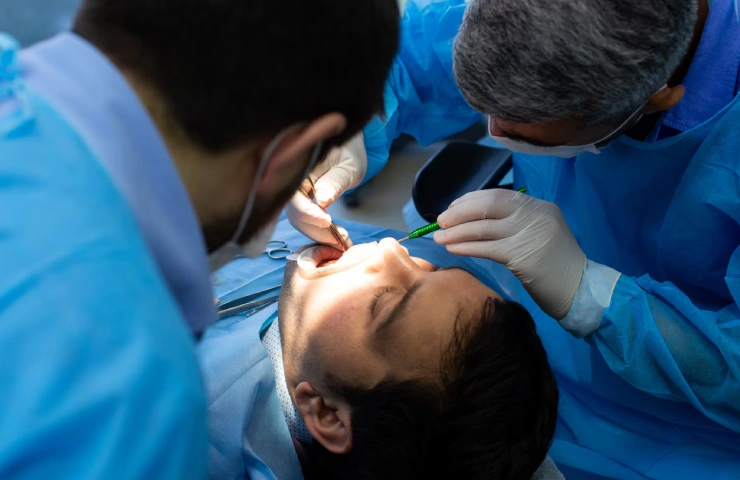
Exploring Anaesthesia for Maxillofacial Surgery: Types, Criteria, and the Role of the anaesthetist
A journey into advancements in anaesthesia and its critical role in surgical precision and patient recovery
Introduction
Maxillofacial surgery, which involves operations on the jaw, face, neck, and other associated structures, poses unique challenges due to the intricate anatomy and functional significance of these regions. Effective anaesthesia management is crucial to minimize discomfort, ensure surgical precision, and facilitate smooth recovery for patients. This blog explores the various types of anaesthesia employed in maxillofacial surgeries, the detailed criteria for choosing the right approach, the integral role of anaesthetists, and the remarkable journey of anaesthesia evolution across generations.
Types of Anaesthesia in Maxillofacial Surgery
General Anaesthesia
General anesthesia has emerged as the cornerstone for complex maxillofacial surgeries, such as reconstructive procedures, trauma management, and tumour excision. By inducing a controlled state of unconsciousness, patients are shielded from pain and distress, allowing surgeons to operate with precision. Modern advancements, such as balanced anesthesia techniques, incorporate multiple agents to stabilize physiological functions and enhance surgical outcomes.
Local Anesthesia
Local anesthesia is widely employed for minor interventions, including dental extractions, small biopsies, and simple cyst removals. Agents like lidocaine and articaine are injected directly into the targeted area, blocking nerve conduction and ensuring pain relief while allowing patients to remain fully conscious. Additionally, topical anaesthetics are often used to enhance patient comfort before injection.
Regional Anesthesia
For procedures requiring extended pain relief in a localized region, regional anesthesia is favoured. Techniques such as maxillary or mandibular nerve blocks provide effective numbness across larger areas, making them ideal for surgeries on the jaw or palate. These methods are highly advantageous for patients sensitive to general anesthesia or those undergoing prolonged procedures.
Conscious Sedation
Conscious sedation blends local anaesthesia with sedative medications that alleviate anxiety and promote relaxation. Patients remain responsive yet experience deep comfort during the surgery. This technique is frequently utilized for patients with heightened fear or mild psychological distress related to surgical interventions.
Combined Techniques
In many cases, the combination of two or more anaesthetic approaches proves beneficial. For example, local anaesthesia paired with conscious sedation is often employed for patients requiring moderate procedures with an added layer of relaxation and pain management. Combined techniques offer flexibility in tailoring the anaesthesia plan to individual needs and surgical demands.
Criteria for Choosing Anaesthesia
Several factors influence the decision-making process when selecting anaesthesia for maxillofacial patients. Each criterion ensures the procedure's safety and success while prioritizing patient comfort:
- Nature and Complexity of Surgery: Extensive or invasive surgeries necessitate general anaesthesia for optimal patient immobility and surgical efficiency, while simpler procedures can be performed under local or regional anaesthesia.
- Patient’s Medical History: Conditions such as cardiac disorders, respiratory issues, or allergies to specific anaesthetic agents must be considered when devising an anaesthetic plan.
- Age Considerations: Paediatric patients may require specialized dosing and monitoring, while elderly individuals may be at increased risk for complications, necessitating customized anaesthesia approaches.
- Psychological Factors: Anxiety or phobia related to surgical interventions often prompts the use of conscious sedation or general anaesthesia to ensure a relaxed state.
- Surgeon-anaesthetist Collaboration: A well-coordinated dialogue between the surgeon and anesthetise is essential for aligning anaesthetic strategies with procedural requirements.
Role of the Anaesthetist
The anaesthetist’s expertise is central to the success of maxillofacial surgery. Their responsibilities encompass every stage of the surgical process:
Preoperative Assessment
Before surgery, the anesthetist conducts a thorough examination of the patient’s medical history, current medications, allergies, and overall health. This assessment helps identify potential risks and design a personalized anesthetic plan tailored to the procedure and patient needs.
Intraoperative Management
During the surgery, the anesthetist meticulously monitors vital signs, such as heart rate, blood pressure, oxygen saturation levels, and respiratory function. Their vigilance ensures the patient remains stable, and they are prepared to intervene immediately in case of unforeseen complications.
Postoperative Care
After the surgery, the anesthetist oversees the recovery process, ensuring the patient regains consciousness comfortably and receives adequate pain relief. They manage side effects like nausea, dizziness, or temporary confusion, optimizing the patient’s overall experience and facilitating smooth recovery.
The Evolution of Anesthesia Safety
The field of anesthesia has evolved significantly over the decades, driven by advancements in science and technology. Early anesthetic practices, which were rudimentary and fraught with risks, have transformed into highly sophisticated systems prioritizing patient safety and well-being. Innovations include:
- Development of safer drug formulations with predictable effects and fewer side effects.
- Integration of cutting-edge monitoring technologies, such as pulse oximetry and capnography, for real-time assessment of patient status.
- Enhanced understanding of pharmacokinetics and pharmacodynamics, enabling precise dosing and reduced complications.
- Introduction of minimally invasive anesthetic techniques, allowing faster recovery and reduced postoperative discomfort.
Conclusion
The selection of appropriate anesthesia is a cornerstone of successful maxillofacial surgery. Through collaboration between surgeons and anaesthetists, patients receive personalized care designed to enhance surgical precision and recovery experiences. Anaesthesia’s evolution underscores the medical community’s commitment to innovation and patient-centred approaches, ensuring the highest standards of safety and comfort.
A Note on Progress
The journey of anesthesia, from its humble beginnings to its current state as a sophisticated medical practice, highlights its transformational impact on healthcare. As practitioners continue to refine techniques and embrace innovations, anesthesia remains a vital pillar in enabling complex surgical procedures and ensuring optimal patient outcomes.

Author
MBBS, MS - General Surgery, MCh - Plastic & Reconstructive Surgery, DAFPRS Fellowship in Aesthetic Surgery
Recent Blog Posts
Laser Hair Removal for Men and Women: What’s the Difference?
November 28, 2025
Ear Pin Back Surgery - Solution To Your Prominent Ear
August 18, 2025
Copyright © 2021-2025, SB Aesthetics. All Rights Reserved. Powered by DigiLantern
